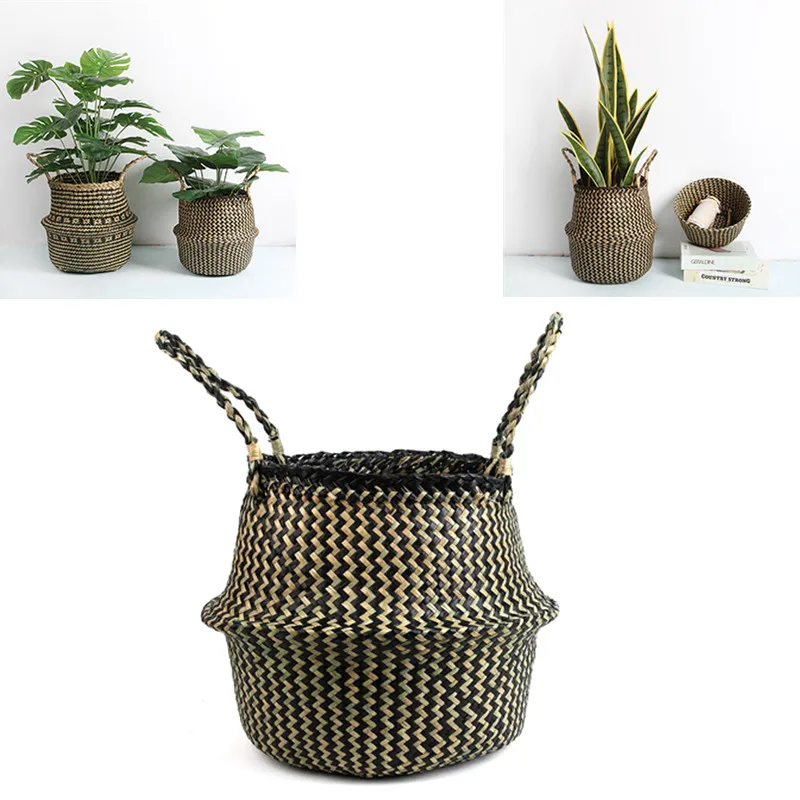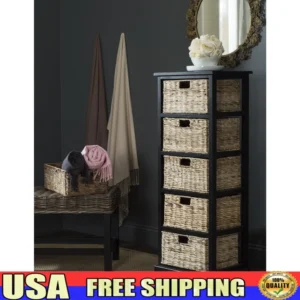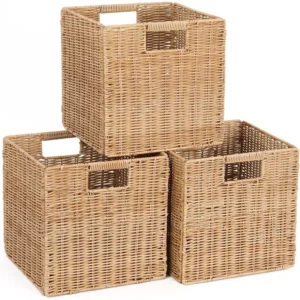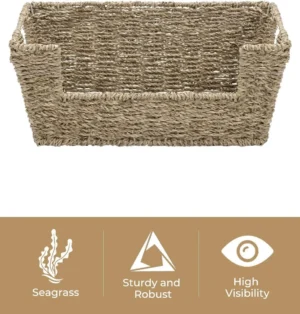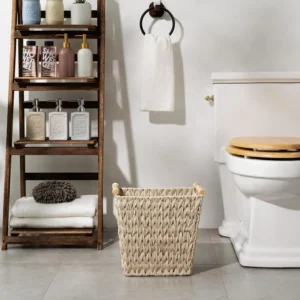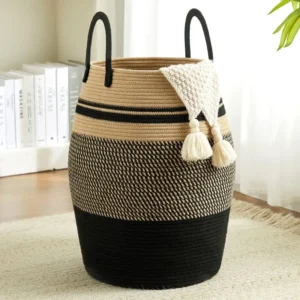Understanding Wicker: Beyond Just Material
When we talk about wicker, many people think it’s a specific material, but it’s actually a weaving technique. This ancient craft creates beautiful, durable products from various materials, both natural and synthetic. The distinctive woven pattern is what defines wicker, not what it’s made from.
Wicker products have become increasingly popular in home decor and organization solutions because they blend functionality with aesthetics. From furniture to storage baskets, wicker items add texture and warmth to any space while serving practical purposes.
The choice between natural wicker vs synthetic options depends on your specific needs, lifestyle, and where you plan to use these items. Some key considerations include:
- Durability requirements
- Indoor vs outdoor use
- Maintenance preferences
- Aesthetic priorities
- Budget constraints
At Tidy Treasure, we believe in “Organizing Life Beautifully,” and our carefully selected wicker baskets embody this philosophy by combining practicality with timeless style.
Natural Wicker: Traditional Charm with Distinctive Character
Natural wicker has been used for thousands of years, creating everything from furniture to storage solutions with distinctive charm and character. These products are crafted from plant materials that bring unique textures and organic warmth to your home.
Common Natural Wicker Materials
Natural wicker can be crafted from several plant-based materials:
- Rattan: A vine-like palm with a solid core, known for its strength and flexibility
- Reed: Thin, pliable strips from the outer skin of rattan
- Bamboo: Hollow, lightweight grass with distinctive nodes
- Willow: Flexible branches that create rustic, traditional looks
- Seagrass: Durable marsh grass with a subtle, earthy aroma
From Plant to Product
The journey from raw material to finished product involves careful harvesting, processing, and skilled craftsmanship. Artisans cut, split, and soak these natural materials to make them pliable enough for weaving. This traditional process has been passed down through generations, with techniques that have stood the test of time.
What sets natural wicker apart is its distinctive character. Each piece has slight variations in color, texture, and pattern – something many homeowners cherish. These subtle imperfections tell the story of natural materials and skilled handwork, creating items that feel genuinely unique.
The eco-friendly wicker basket materials used in natural wicker appeal to environmentally conscious consumers who value sustainability alongside beauty. The traditional craftsmanship involved in creating rattan baskets and other natural wicker items adds a level of artistry that mass-produced alternatives often lack.
Synthetic Wicker: Modern Innovation for Contemporary Needs
Synthetic wicker represents a significant innovation in the world of home furnishings and organization. Also known as resin wicker or all-weather wicker, these materials were developed to address the limitations of natural fibers while maintaining their aesthetic appeal.
Common Synthetic Wicker Materials
Modern synthetic wicker is typically made from various plastics and resins:
- High-Density Polyethylene (HDPE): Premium option known for durability and UV resistance
- Polyethylene (PE): Common material offering good weather resistance at a moderate price point
- Polyvinyl Chloride (PVC): Budget-friendly option, though typically less durable than HDPE or PE
Manufacturing Process
The production of synthetic wicker begins with melting the chosen polymer, which is then extruded into fibers designed to mimic the look and feel of natural materials. These fibers are woven around frames (typically aluminum or steel) in patterns that closely resemble traditional wicker weaving techniques.
What makes synthetic wicker particularly remarkable is how far the technology has advanced. Early versions looked obviously artificial, but today’s high-quality synthetic wicker can be surprisingly difficult to distinguish from natural materials at first glance. Manufacturers have perfected textures, colors, and even the subtle variations that make natural wicker so appealing.
The most significant innovation comes in the development of synthetic vs natural wicker that can withstand outdoor conditions. Special UV stabilizers prevent fading and deterioration from sunlight, while the non-porous nature of these materials ensures they won’t absorb water, preventing mold and mildew growth. This makes them ideal for storage utility items that might be exposed to changing conditions.
Advantages of Natural Wicker: Why Traditional Still Matters
Natural wicker continues to be a popular choice for many homeowners despite advances in synthetic alternatives. Here’s why many people still prefer the real thing:
Authentic Beauty: Natural wicker has a warmth and character that’s difficult to replicate. The subtle color variations and organic textures create visual interest that synthetic materials often lack.
Lightweight Construction: Most natural wicker pieces weigh significantly less than their synthetic counterparts, making them easier to move and rearrange as needed.
Environmental Benefits: As renewable resources that biodegrade at the end of their lifecycle, natural materials like rattan and bamboo are more environmentally friendly than petroleum-based synthetics.
Comfort and Flexibility: Natural wicker has a slight give that can make furniture more comfortable. This subtle flexibility creates a more forgiving feel when used in seating.
Artisanal Value: The craftsmanship involved in creating natural wicker pieces represents generations of skill and tradition. Many people value this connection to traditional crafts and artisanal production.
Timeless Appeal: Natural wicker has remained popular for centuries because its aesthetic complements virtually any design style from traditional to contemporary.
Natural Aging Process: Like fine wood, quality natural wicker develops a beautiful patina over time that adds to its character rather than detracting from it.
When considering how to care for wicker baskets, natural materials do require more attention, but many owners feel the distinctive beauty and authentic feel are worth the extra effort.
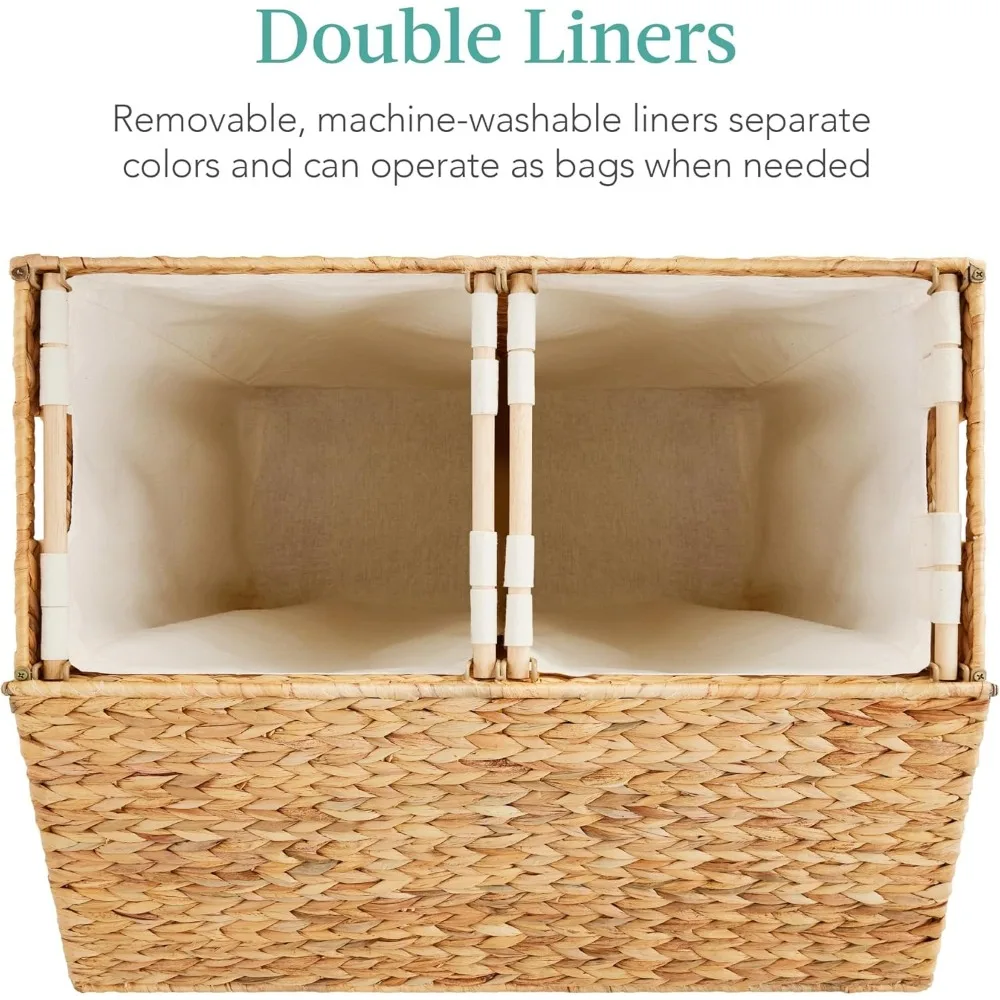
Advantages of Synthetic Wicker: Modern Solutions to Age-Old Problems
Synthetic wicker has revolutionized how we use woven furniture and storage solutions by addressing many of the limitations of natural materials. Here are the key benefits that make synthetic wicker increasingly popular:
Exceptional Durability: High-quality synthetic wicker can last for many years without significant degradation. The materials resist cracking, peeling, and breaking even with regular use.
Weather Resistance: Perhaps the most significant advantage is the ability to withstand outdoor conditions. Synthetic wicker resists damage from:
- UV radiation that would fade natural materials
- Rain and moisture that would cause natural wicker to swell and warp
Temperature fluctuations that would make natural fibers brittle
Minimal Maintenance: Synthetic wicker requires very little upkeep. Usually, a simple rinse with a hose or wipe with a damp cloth is all that’s needed to keep it looking fresh.
Resistance to Common Problems: Unlike natural materials, synthetic wicker won’t develop mold or mildew in humid conditions and is completely resistant to insect damage.
Color Stability: The color is integrated throughout the material rather than applied as a surface finish, which means synthetic wicker maintains its appearance much longer without fading.
Design Versatility: Manufacturers can produce synthetic wicker in virtually any color or pattern, offering more design options than what’s possible with natural materials.
Consistency: Each piece has uniform quality and appearance, which can be important for matching sets or creating a cohesive look.
When choosing between synthetic natural wicker, the practical benefits often make synthetic the more logical choice for many applications, especially in wicker storage baskets that might be used in bathrooms or outdoors.
Limitations of Natural Wicker: Understanding the Challenges
While natural wicker offers undeniable charm, it comes with several limitations that should factor into your purchasing decision:
Vulnerability to Moisture: Natural wicker absorbs water, which can cause swelling, warping, and eventually, structural damage. This makes it problematic in humid environments like bathrooms or outdoor spaces.
Sun Damage: Prolonged exposure to sunlight causes natural wicker to dry out, becoming brittle and prone to breaking. It also leads to significant fading of both the material itself and any applied finishes.
High Maintenance Requirements: Keeping natural wicker in good condition requires regular cleaning with special brushes, occasional resealing or repainting, and protection from environmental factors.
Indoor Limitations: Most natural wicker pieces are best used indoors or in fully protected outdoor spaces. Even screened porches may not provide adequate protection in severe weather.
Pest Susceptibility: Natural fibers can attract insects like beetles and borers that damage the material from within. Prevention requires regular inspection and sometimes treatment.
Fragility Under Heavy Use: While natural wicker can be surprisingly strong, it doesn’t handle rough treatment well. Heavy items stored in natural wicker baskets can cause stretching and eventual breakage.
Seasonal Considerations: In harsh climates, natural wicker outdoor pieces must often be stored inside during winter months to prevent damage.
When considering natural vs synthetic wicker laundry solutions, these limitations become particularly important since laundry environments often involve moisture and heavier loads.
Limitations of Synthetic Wicker: Where Traditional Still Wins
Despite its many practical advantages, synthetic wicker isn’t perfect. Understanding its limitations helps you make an informed decision:
Aesthetic Differences: Even the highest quality synthetic wicker lacks some of the subtle texture variations and organic character of natural materials. Discerning eyes can usually tell the difference.
Environmental Impact: Most synthetic wicker is made from petroleum-based plastics that aren’t biodegradable. Production processes can have significant carbon footprints, making this a less eco-friendly option.
Heat Absorption: Dark-colored synthetic wicker can become uncomfortably hot when placed in direct sunlight, sometimes even too hot to touch. This can be problematic for outdoor furniture.
Quality Inconsistency: There’s a vast difference between high-end and budget synthetic wicker. Lower-quality products may become brittle, fade dramatically, or unravel within just a season or two.
Limited Repairability: When synthetic wicker does break or unravel, it’s much harder to repair than natural wicker. Damaged pieces often need complete replacement rather than simple mending.
Less “Breathability”: The non-porous nature of synthetic materials means items stored in these baskets don’t benefit from air circulation the way they would in natural wicker containers.
Texture and Feel: Synthetic wicker often feels different to the touch—sometimes smoother or more plastic-like than the natural alternative, which can detract from the sensory experience.
The choice between wicker baskets with lids made from natural or synthetic materials often depends on whether these limitations outweigh the practical benefits for your specific situation.
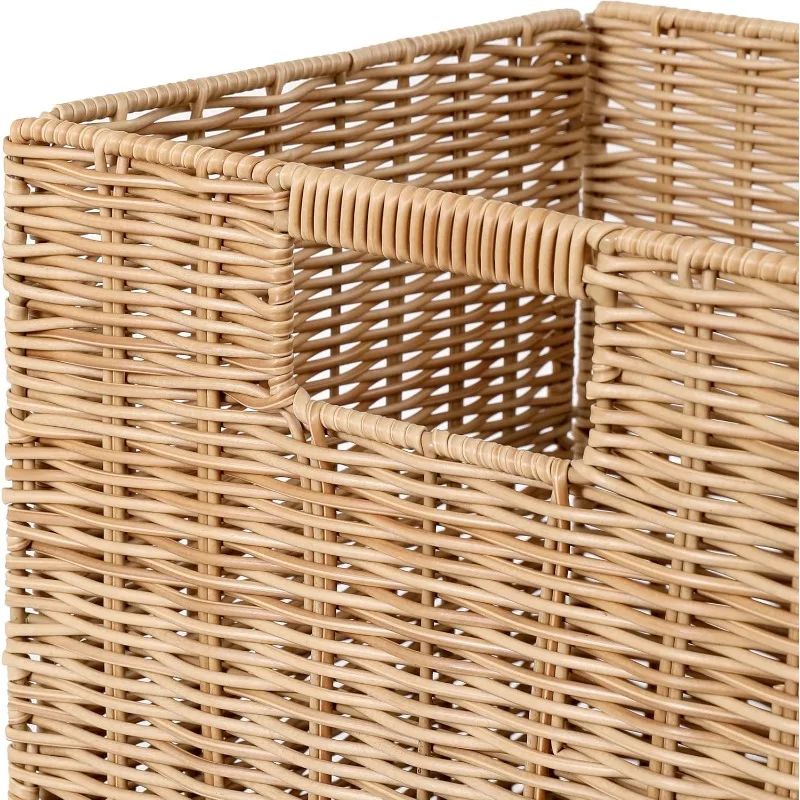
Ideal Uses for Natural Wicker: Where It Shines
Natural wicker finds its perfect place in specific environments and applications where its beauty can be appreciated and its limitations aren’t problematic:
Living Room Storage: Decorative baskets for magazines, throws, or remote controls add warmth and texture while keeping items organized.
Bedroom Organization: Hampers, under-bed storage, and dresser-top containers create a cozy, relaxed atmosphere while serving practical purposes.
Home Office Solutions: Letter trays, waste baskets, and desktop organizers bring natural elements into work spaces.
Sheltered Outdoor Spaces: Covered patios, screened porches, and gazebos with good protection from direct weather can safely house natural wicker pieces.
Dining Areas: Bread baskets, serving trays, and napkin holders make mealtime more elegant with their traditional appeal.
Natural wicker is particularly well-suited for spaces where:
– Climate control keeps humidity levels moderate
– Direct sunlight exposure is limited
– Visual warmth and texture are design priorities
– Items being stored are lightweight and dry
The decorative wicker baskets for home style can transform ordinary storage into beautiful design elements, adding character while maintaining functionality.
Ideal Uses for Synthetic Wicker: Perfect Applications
Synthetic wicker excels in challenging environments where natural materials would quickly deteriorate:
Outdoor Patios and Decks: Furniture, storage boxes, and planters that face full exposure to the elements need synthetic wicker’s weather resistance.
Bathroom Storage: Hampers, towel baskets, and organizers in high-humidity bathrooms benefit from mold and mildew resistance.
Family Rooms: Homes with children and pets need the durability and easy cleaning that synthetic wicker provides for heavily used items.
Poolside Areas: The combination of chlorine, water splashes, and intense sun makes synthetic the only practical wicker option for pool areas.
Vacation Properties: Second homes that might go unattended for long periods need low-maintenance storage solutions that won’t deteriorate.
Garages and Mudrooms: These transitional spaces expose storage to temperature fluctuations and occasional moisture, making synthetic wicker ideal.
Synthetic wicker is perfect for:
– Areas with exposure to weather elements
– Spaces with significant humidity fluctuations
– High-traffic zones where durability is essential
– Places where low maintenance is a priority
For practical everyday items like wicker waste baskets, synthetic materials offer the perfect balance of appearance and functionality in both dry and humid environments.
How to Identify Quality: A Buyer’s Guide
Not all wicker is created equal. Here’s how to spot quality pieces regardless of whether you choose natural or synthetic:
| Quality Indicator | Natural Wicker | Synthetic Wicker |
|---|---|---|
| Weave Pattern | Tight, consistent weaving with minimal gaps | Uniform pattern with secure connections |
| Material Feel | Flexible but firm, not brittle or dry | Smooth, consistent texture without sharp edges |
| Construction | Solid core materials, reinforced corners | UV-stabilized fibers, aluminum frames |
| Weight | Appropriate weight for size (not too light) | Substantial feel indicating quality resin |
| Finish | Smooth surface without splinters or rough areas | No visible mold lines or manufacturing defects |
| Joints | Carefully wrapped joints with no exposed ends | Seamless connections with hidden attachment points |
When examining natural wicker, gently press on the weaving—quality pieces will feel springy rather than brittle. Look for consistent coloration and uniform fiber width throughout. The material should smell natural, not of chemicals or mustiness.
For synthetic wicker, check that color runs throughout the material rather than just on the surface (which could indicate cheap spray painting). High-quality synthetic wicker often comes with warranties against fading and structural failure.
Pay attention to how the piece is constructed. Quality wicker items feature reinforced edges and carefully finished surfaces without rough spots. In furniture, examine the frame underneath—aluminum is preferable to steel for outdoor use due to its rust resistance.
Understanding the differences between natural vs synthetic rattan helps you identify genuine materials and make informed choices based on your needs.
Care and Maintenance Comparison: Keeping Your Wicker Beautiful
Proper maintenance significantly extends the life of your wicker items. Here’s how care requirements compare:
| Maintenance Task | Natural Wicker | Synthetic Wicker |
|---|---|---|
| Regular Cleaning | Dust with soft brush weekly | Wipe with damp cloth as needed |
| Deep Cleaning | Mild soap solution with soft brush 2-4 times yearly | Hose down or use mild soap solution 1-2 times yearly |
| Moisture Protection | Keep away from humidity; use dehumidifiers in damp areas | No special precautions needed |
| Sun Protection | Rotate items to prevent uneven fading; keep out of direct sun | No rotation needed; can withstand direct sun |
| Seasonal Care | Apply furniture oil or sealant annually | None required beyond normal cleaning |
| Storage | Climate-controlled, dry environment when not in use | Can remain in place year-round |
| Repair | Can often be rewoven or repaired by specialists | Usually requires replacement of damaged sections |
Natural wicker benefits from occasional light misting in very dry environments to prevent excessive drying and cracking. However, never soak natural wicker or leave it damp. Use compressed air to clean tight weaves where dust might accumulate.
Synthetic wicker is remarkably low-maintenance but still benefits from occasional cleaning to prevent dirt buildup. For stubborn stains on synthetic wicker, a soft brush with diluted vinegar solution works well without damaging the material.
Both types should be lifted rather than dragged when moved to prevent structural damage. Check wicker laundry baskets regularly for signs of wear, especially at stress points where handles attach.
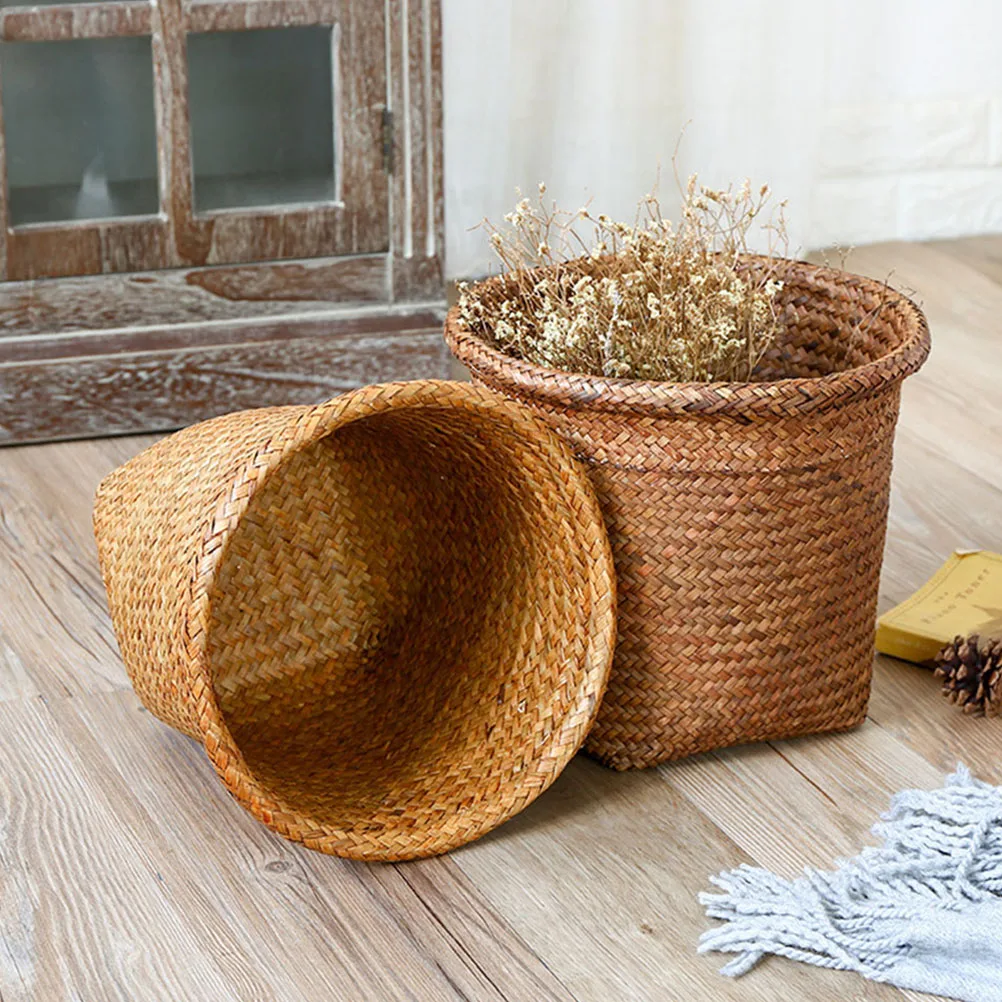
Making Your Decision: A Personalized Approach
Choosing between natural and synthetic wicker comes down to balancing your specific needs, environment, and preferences. Consider these key questions:
Where will you use the item?
– Outdoor or high-moisture areas → Synthetic wicker
– Climate-controlled indoor spaces → Either option worksHow important is authenticity?
– Highly value traditional craftsmanship → Natural wicker
– Prioritize function over traditional materials → Synthetic wickerWhat’s your maintenance tolerance?
– Willing to perform regular care → Natural wicker is manageable
– Prefer minimal upkeep → Synthetic wicker is betterHow will it be used?
– Decorative purposes or light storage → Natural wicker
– Heavy use, children, pets → Synthetic wickerWhat’s your environmental priority?
– Biodegradability and renewable resources → Natural wicker
– Longevity and reduced replacement → High-quality synthetic wicker
Many homeowners find that a mixed approach works best—using synthetic wicker in challenging environments like bathrooms and outdoor spaces while enjoying natural wicker in protected indoor areas. Choosing between natural synthetic wicker doesn’t have to be all-or-nothing.
For areas that transition between indoors and outdoors, consider wicker baskets with handles in synthetic materials for maximum versatility and durability.
Black Wicker Baskets, Rattan Storage Baskets, Tall Wicker Baskets, Wicker Shelf Baskets, Woven Storage Baskets
5-Tier Distressed Black Wood Frame Storage Tower with Removable Wicker Baskets for Home Organization$715.80 Select options This product has multiple variants. The options may be chosen on the product pageWicker Laundry Baskets, Woven Laundry Baskets, Woven Storage Baskets
$392.02 Select options This product has multiple variants. The options may be chosen on the product pageRattan Shelf Baskets, Rattan Storage Baskets, Small Wicker Baskets, Square Wicker Baskets
Square Plastic Wicker Storage Baskets Set of 3 with Collapsible Design for Cube Storage Organization$185.47 Select options This product has multiple variants. The options may be chosen on the product pageWicker Baskets with Handles, Wicker Storage Baskets, Woven Storage Baskets
$137.92 Select options This product has multiple variants. The options may be chosen on the product page- $119.02 Select options This product has multiple variants. The options may be chosen on the product page
Large Wicker Laundry Baskets, Tall Wicker Baskets, Woven Laundry Hampers, Woven Storage Baskets
$130.54 Select options This product has multiple variants. The options may be chosen on the product page
Frequently Asked Questions
Is synthetic wicker truly waterproof?
High-quality synthetic wicker is indeed waterproof. The materials don’t absorb water, so they won’t swell, warp, or develop mold when exposed to moisture. However, if water pools in the weaving pattern, it should be dried to prevent dirt accumulation.
How long does natural wicker typically last?
With proper care and indoor use, natural wicker can last 10-20 years or more. However, this lifespan shortens dramatically if exposed to moisture, direct sunlight, or extreme temperature changes.
Can natural wicker ever be used outdoors?
Natural wicker can be used in fully protected outdoor areas like covered porches, but only with regular maintenance and during fair weather. It should never be exposed to rain or intense sunlight and should be brought indoors during adverse weather conditions.
How can I tell if a basket is made of natural or synthetic wicker?
Natural wicker has slight variations in color and texture, often feels warmer to the touch, and may have a subtle natural scent. Synthetic wicker typically has more uniform coloring, might feel slightly plastic-like to the touch, and maintains perfect consistency in the weaving pattern.
Is synthetic wicker environmentally friendly?
While not biodegradable like natural materials, high-quality synthetic wicker contributes to sustainability through its longevity. By lasting many years longer than natural alternatives in challenging environments, it reduces the need for frequent replacement. Some manufacturers are also beginning to use recycled plastics in their synthetic wicker products.
Does the color of synthetic wicker fade over time?
Quality synthetic wicker contains UV inhibitors that significantly reduce fading. While some minimal color change might occur over many years, it’s much less pronounced than with natural wicker. Budget synthetic wicker, however, may fade considerably without proper UV protection in its formulation. The safety of synthetic wicker for laundry and other household uses includes its color stability over time.
How to Incorporate Wicker Storage Solutions Throughout Your Home
Wicker storage pieces are versatile enough to work in every room, adding both function and style:
Living Room
* Use large baskets for throw blankets and pillows
* Incorporate wicker magazine holders beside seating
* Store remotes and small electronics in lidded baskets
Kitchen
* Add fruit baskets for counter storage
* Use wicker bins in pantries for snacks or produce
* Store table linens in decorative wicker containers
Bathroom
* Choose synthetic wicker for towel storage
* Use small baskets for toiletries and cosmetics
* Replace plastic trash bins with wicker waste baskets
Bedroom
* Store out-of-season clothing in under-bed wicker containers
* Use decorative baskets on dressers for jewelry and accessories
* Replace traditional hampers with ventilated wicker versions
When selecting wicker for different spaces, consider both function and visual weight. Lighter, more open weaves create an airy feel in smaller spaces, while tighter, more substantial weaving adds coziness to larger rooms. Mixing wicker with other textures—like ceramics, glass, and textiles—creates visual interest and prevents the space from feeling one-dimensional.
Remember that wicker doesn’t have to match perfectly throughout your home. Different weaving patterns and even mixing natural with synthetic wicker can create a collected-over-time look that adds character to your spaces.

